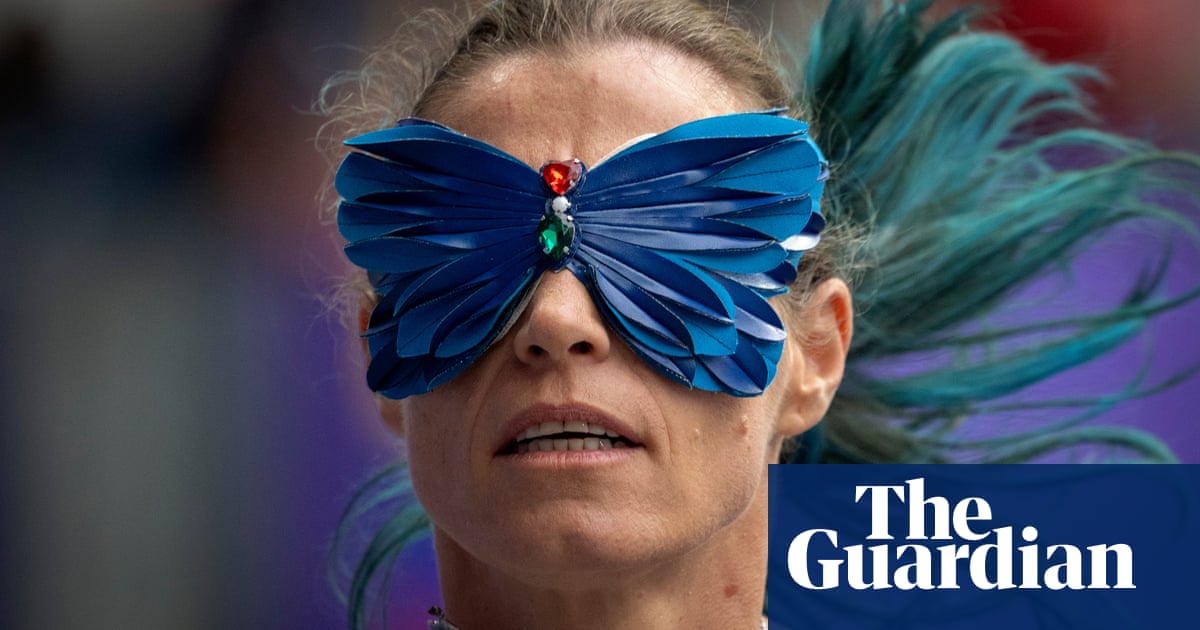While Paralympic athletes have been capturing the limelight with feats of skill and endeavour over the past fortnight, theirs are not the only remarkable stories from the Games. Several photographers with disabilities have been creating striking images in Paris, defying mobility issues, visual impairments and societal expectations in the process. Here is some of their best work.
“My photography relies more on my feelings, sensations and emotions than on vision,” says João Batista Maia da Silva, who lost most of his sight in his late 20s after contracting uveitis.
The Brazilian photographer pursues his passion “using my tactile, olfactory and auditory perceptions, as well as my heart” and says he hopes his story can inspire others.
Helped by a guide who explains each scene to him, Da Silva, who has attended three Paralympics, says he particularly enjoys photographing blind five-a-side football because it happens in total silence, and goalball in which players attempt to throw a ball embedded with bells into the opposition’s net.
“What’s special about goalball is that it’s not an adapted sport – it was created exclusively for visually impaired people,” he says. “This photo (below) is a clear example of me using my auditory perceptions to capture it. The athletes were warming up, jumping, and the impact of their feet hitting the court guided my photography.”
“The Paralympics is a phenomenon that you’re touched by and you never forget,” says the veteran news photographer Emilio Morenatti. “At the swimming pool, you really feel the empathy and connection. You see people crying in the stands, sharing in the moment as the last swimmer finishes, not just the first swimmer. For me, it’s much more inspiring than the Olympics.”
The Spaniard, who shoots for Associated Press, lost his lower left leg in Afghanistan in 2009 when an improvised explosive device detonated close to his vehicle.
“I was in a good moment in my career, winning awards, and then suddenly I was without a leg,” he says. “I was a very agile man before then, so I thought to myself: ‘What next?’ Should I become an editor or something other than a photographer? And then I thought: ‘No, I’m going to give photography another chance.’”
Morenatti uses a range of prosthetic limbs depending on the terrain but says that choosing the best leg for the job can be more time-consuming than choosing which camera kit to take.
“With only one leg, I have to be sharper,” he says. “If I carry too much equipment in my flat-jacket then my prosthetic leg is not going to work properly. I also have to find shortcuts to reach places so that I have enough energy left to concentrate when it’s time to shoot.”
Among Morenatti’s favourite shots from the 2024 Paralympics is an emotive frame of the Brazilian swimmer Gabriel Geraldo dos Santos Araújo, AKA Gabrielzinho, celebrating after he won the S2 100m backstroke final. Araujo was born with the congenital disease phocomelia which hindered the development of his arms and legs, but he propels himself through the pool by undulating his body.
“I first discovered him in Tokyo and realised that he celebrates by spitting water, because it’s his only way to communicate in the pool. He’s a very powerful and happy man, and when he’s competing you can guarantee it’s going to be a party.”
“Growing up with a disability, I’ve often been the outlier,” says the student photographer Samantha Hurley, who has albinism and is legally blind.
“People with disabilities are often told or expected to not be able to do certain things, so it was really cool to be immersed in a global celebration of people with disabilities and to watch athletes defy society’s expectations, while I was also defying what people expect of a photographer.”
Due to her condition, Hurley has light sensitivity and “my eyes rock back and forth constantly because they’re trying to get a clear picture, but they never quite can … so everything looks over overexposed and out of focus.”
Nevertheless, she has been taking photographs since she was a child and was thrilled when selected by her university to attend the Games on behalf of AP. “Photography feels cathartic to me,” she says. “It’s a personal way to learn how I see, and to see the world.”
Hurley says her favourite photos in Paris were of triumphant athletes. “From where I was sitting, I typically didn’t have proximity to see the looks on people’s faces when they won, so being able to view that through my camera was really cool.”
Photography has been a lifeline for Ian Rice, who was diagnosed with primary progressive multiple sclerosis in his 40s, after a career in finance and the energy sector.
“Initially, I didn’t take to my wheelchair at all well,” he says. “I was in the worst possible mental health space, but taking up photography helped me to get out of the house.”
After working with the Royal Ballet and having a photo published in Rugby World magazine, Rice requested access to shoot portraits of Olympians and Paralympians in the lead-up to Paris. Then he contacted the photo agency Agence France-Presse which he knew had recently analysed its own workplace diversity.
“Normally, being over 50 and disabled in the UK means you’re unemployable because of discrimination, even when you’ve got 25 years of work experience and an MBA like I have,” says Rice. “So for AFP to engage me, it blows my mind. I cannot thank them enough.
“I’ve been working in the company of photographic legends like Franck Fife, who is an inspiration to me. I can’t always get into the same positions as other photographers – I can’t go up into the rafters and I’m a bit like a Dalek when faced by stairs – but I try to be as creative as I can be.
“I’ve been shooting triathlon, badminton, goalball, tennis. Every day has been like a red letter day for me.”
